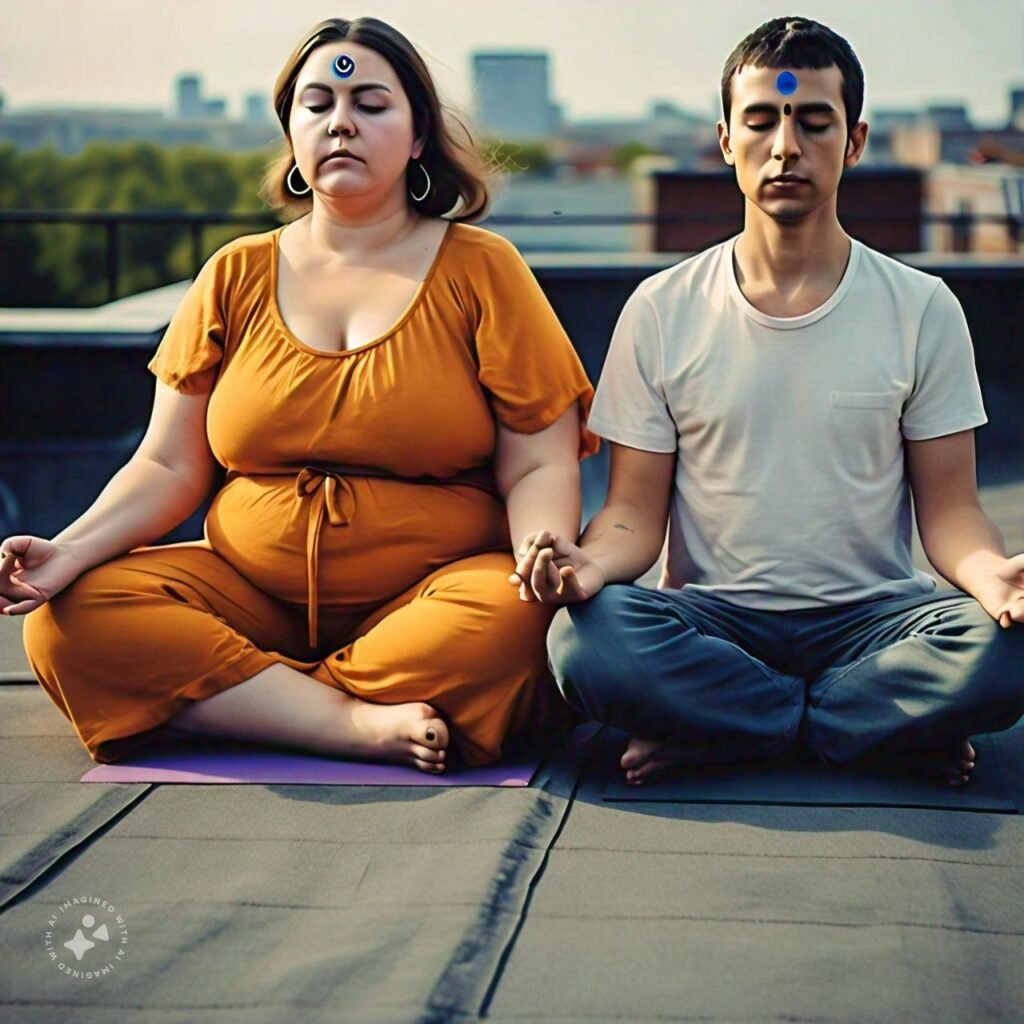
The pineal gland secretes melatonin, a hormone that regulates the body’s circadian rhythm or sleep-wake cycle. Melatonin production increases in response to darkness, signaling to the body that it’s time to sleep, and decreases in light, helping to maintain a proper sleep cycle. The pineal gland is sometimes referred to as the “third eye” due to its role in responding to light and darkness.
The pineal gland may also influence reproductive hormones and seasonal biological rhythms in animals, although this is less prominent in humans.

When the pineal gland is “activated,” it typically refers to the increased secretion of melatonin or its enhanced role in regulating the body’s natural rhythms. Activation of the pineal gland can occur in response to darkness or practices such as meditation, and some people associate it with a heightened state of consciousness.



Potential Effects of Pineal Gland Activation:
Relaxation and Stress Reduction: Higher melatonin levels can promote a calming effect, reducing stress and improving relaxation.
Improved Sleep: Increased melatonin secretion leads to better sleep regulation. This can result in improved sleep quality, easier time falling asleep, and waking up refreshed.
Enhanced Circadian Rhythm: A well-functioning pineal gland helps maintain the body’s internal clock, supporting a regular sleep-wake cycle, mood regulation, and energy levels throughout the day.

Improved Intuition and Perception (Spiritual Belief): Some spiritual traditions believe that activating the pineal gland, sometimes called the “third eye,” enhances intuition, insight, and a deeper sense of awareness or connection with the universe.
Potential Influence on Mood: By regulating sleep and circadian rhythm, a balanced pineal gland may indirectly support emotional well-being and mood stability.



Beyond its well-established role in sleep regulation, some theories and beliefs suggest additional effects of pineal gland activation that extend into more speculative or spiritual realms. Here are a few more ideas and potential outcomes linked to its activation:



Additional Concepts Around Pineal Gland Activation:
Lucid Dreaming: Some believe that stimulating the pineal gland may enhance dream clarity, vividness, and even control over dreams, known as lucid dreaming. This idea stems from the fact that the gland is active during REM sleep, the stage most associated with dreaming.

Heightened Spiritual Awareness: In various spiritual traditions, particularly those influenced by Hinduism, Buddhism, and New Age beliefs, the pineal gland is referred to as the “third eye.” Activation is said to lead to greater spiritual insight, heightened perception, and a deeper connection to one’s inner self or the divine.



DMT Production Hypothesis: Some researchers have hypothesized that the pineal gland produces DMT (dimethyltryptamine), a powerful hallucinogenic compound. DMT is sometimes referred to as the “spirit molecule” due to its profound effects on consciousness, and the theory suggests that the pineal gland may be involved in producing DMT during near-death experiences or intense spiritual experiences. However, this idea is not fully proven scientifically.



Breathing Exercises: Breathwork, particularly forms like pranayama in yoga, is believed to oxygenate the brain and stimulate the pineal gland, promoting clarity and focus.



Diet and Detoxification: Some people believe that certain diets, especially those avoiding fluoride and promoting detoxifying foods, can “decalcify” the pineal gland. This is based on the idea that fluoride exposure leads to calcification, which may impair the gland’s function.



Scientific Limitations:
While much of the biological function of the pineal gland is well-understood, particularly in regulating sleep and circadian rhythms, many of the more mystical or metaphysical aspects of pineal gland “activation” are not scientifically proven. Claims about enhancing psychic abilities or producing DMT remain speculative and largely based on anecdotal evidence rather than empirical data.



Pineal Gland Activation and Popular Culture:
In modern pop culture and certain spiritual movements, the pineal gland is often portrayed as the gateway to higher consciousness or enlightenment. This view is influenced by a variety of historical, religious, and esoteric traditions, as well as more recent scientific discoveries about the gland’s role.



Third Eye Symbolism:
The association of the pineal gland with the “third eye” comes from ancient spiritual texts, particularly in Hinduism, where it is referred to as the ajna chakra. This chakra is believed to govern intuition, insight, and spiritual wisdom. In popular culture, the third eye is often depicted as a mystical symbol of awakening or spiritual power.

Conspiracy Theories:
Some conspiracy theories suggest that the pineal gland is deliberately suppressed by modern society (through exposure to fluoride, toxins, etc.) to prevent people from achieving higher states of consciousness. This view is not supported by mainstream science, but it persists in certain circles.



The Role of Psychedelics:
Interest in substances like DMT and other psychedelics has grown in connection with the idea of pineal gland activation. Some speculate that psychedelics can stimulate or mimic the effects of pineal activation, providing experiences of deep insight, spiritual awakening, or altered states of consciousness. Research into the therapeutic potential of psychedelics in mental health treatment is ongoing, though it remains a contentious field.

The pineal gland’s biological role is clearly linked to regulating sleep, melatonin production, and circadian rhythms. While many spiritual and metaphysical traditions assign the gland additional functions—such as enhancing intuition, perception, or spiritual awakening—these ideas remain speculative from a scientific perspective. Nonetheless, the pineal gland continues to fascinate both scientists and spiritual seekers alike due to its unique function and symbolism.



Ajna is often considered the gateway to higher consciousness, inner wisdom, and insight. When balanced, it is believed to enhance one’s clarity of thought, intuition, and the ability to see beyond the physical. Symbolically, it is represented by a two-petaled lotus and is associated with the color indigo or deep blue.
Meditation, visualization, and self-reflection are commonly used practices to activate and balance the Ajna Chakra.



The Ajna Chakra is closely linked to the pineal gland, which some traditions believe to be the physical manifestation of the “third eye.” It governs the mind, eyes, and perception of both inner and outer realities. When this chakra is balanced, individuals may experience heightened intuition, psychic abilities, clarity, and a deep connection to their inner wisdom.

The Ajna Chakra becomes blocked or unbalanced, it can lead to confusion, lack of focus, overthinking, or even headaches and vision problems. An overactive Ajna may cause people to become overly detached from reality, lost in fantasies, or overly reliant on intellect without emotional balance.



Practices like yoga, meditation, and pranayama (breathing exercises) are often used to bring the Ajna Chakra into harmony. Engaging with activities that encourage mindfulness, creativity, and awareness can also help open and balance this chakra, allowing for greater spiritual awakening and personal transformation.

Third eye meditation is a practice aimed at awakening or opening the third eye, which is believed to be a gateway to higher consciousness and spiritual insight. Here’s how you can practice it:



1. Find a Quiet Place:
Sit in a comfortable position, in a place where you won’t be disturbed. You can sit cross-legged on the floor or on a chair, with your back straight.
2. Relax and Focus on Your Breathing:
Close your eyes and take deep, slow breaths. Inhale through your nose, hold it for a few seconds, and then exhale slowly. This helps relax your body and quiet your mind.

3. Focus on the Area Between Your Eyebrows:
Direct your attention to the spot between your eyebrows. This is where the third eye is believed to be located. Gently bring your awareness to this area, and try to visualize a point of light or energy in this space.
4. Chant or Mentally Repeat a Mantra:
Some people find it helpful to use a mantra to maintain focus. You can choose a traditional mantra like “Om” or create one that resonates with you, repeating it either out loud or silently in your mind. The vibration of chanting can help stimulate the third eye.



5. Visualize Light and Energy:
Imagine a beam of light or energy flowing to your third eye, filling it with warmth and illumination. This can be white light, purple, or indigo, which are colors often associated with the third eye chakra.
6. Stay in the Present Moment:
If your mind starts to wander, gently bring it back to the focus on your third eye or your mantra. Don’t be frustrated by distractions—acknowledge them and return your attention to the practice.

7. End the Meditation Gradually:
After meditating for 10-20 minutes, gradually bring your awareness back to your surroundings. Open your eyes slowly and take a few deep breaths before standing up.
8. Consistency:
Practice regularly to gradually strengthen your connection with your third eye.



10. Observe Any Sensations or Experiences:
As you practice third eye meditation over time, you may notice sensations like tingling or warmth in the area between your eyebrows. Some people report experiencing vivid imagery, enhanced intuition, or deeper understanding. These sensations are often seen as signs of the third eye opening or activating.



12. Incorporate Visualization Techniques:
Another way to deepen third eye meditation is by using more elaborate visualizations. You can imagine a lotus flower blossoming at the third eye, or a spiral of light expanding from the center of your forehead, representing higher knowledge.



13. Enhance Your Practice with Crystals or Aromatherapy:
Some people use crystals like amethyst or lapis lazuli, which are associated with the third eye, to enhance meditation. You can place the crystal on your forehead or hold it in your hand. Aromatherapy oils like frankincense, sandalwood, or lavender can also be used to create a calming atmosphere and aid in meditation.

14. Maintain a Balanced Lifestyle:
To fully benefit from third eye meditation, it’s essential to maintain balance in other areas of your life. Eat nutritious foods, get regular exercise, and maintain a positive mindset. Meditation is more effective when the mind and body are in harmony.



15. Listen to Your Intuition:
As you practice, your intuitive abilities may start to strengthen. Pay attention to any new insights, feelings, or guidance that may come from within. These are signs that your third eye is becoming more active and responsive.
With consistent practice, third eye meditation can help you develop greater self-awareness, spiritual insight, and a sense of connection to the universe.


